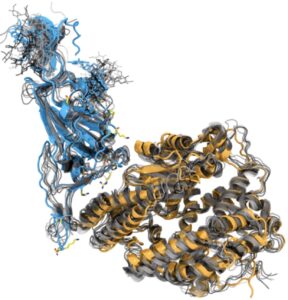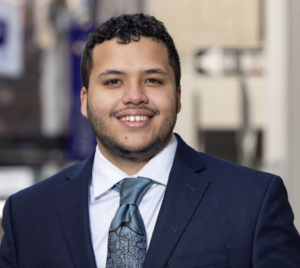Decisive achievement

The GenSLM algorithm used an AI-based model to predict COVID-19 variants of concern. The blue and yellow ribbons show the model’s predicted variant of the SARS-CoV-2 spike protein laid over the protein structure observed in the BQ.1 variant (gray), which was widespread in late 2022. (Image: Defne G. Ozgulbas/University of Illinois Urbana-Champaign.)
When COVID-19 loomed as a public health threat in early 2020, Danilo Pérez-Rivera was a neurobiology research technician at the University of Puerto Rico Medical School and applying to graduate school. The pandemic was poised to exacerbate entrenched challenges on the island, including a lack of health leadership and a medical personnel shortage. Though only 24 years old at the time, Pérez-Rivera was recruited as part of an interdisciplinary team of scientists, mathematicians, engineers and artists to fill an urgent need: building a data-based system to track testing, hospitalizations and more as the foundation of the island’s pandemic response.
The effort, now known as SMICRCPR (the Spanish acronym for the Puerto Rico Municipal Case Investigation and Contract Tracing System), eventually grew to more than a thousand people, with Pérez-Rivera the project’s scientific advisor and keeper of the data dashboard and its website’s daily updates. Even after he chose New York University for graduate school, he delayed his move until January 2021 to support the team’s work.
The project demonstrates how Pérez-Rivera has applied his broad interests in math, health, neuroscience, chemistry and computing to societal problems, particularly in Puerto Rico, his mother’s birthplace and his home since he was 8. “When I saw science could save lives, I really wanted to dedicate myself to do something meaningful so that I was contributing to my community.”
Pérez-Rivera has continued that work as a Department of Energy Computational Science Graduate Fellowship (DOE CSGF) recipient. During his 2022 Argonne National Laboratory practicum, he contributed to an artificial intelligence-based model, GenSLM, that predicted how new SARS-CoV-2 virus variants evolve. That project was awarded the 2022 Gordon Bell Special Prize for High-Performance Computing-Based COVID-19 Research.
He grew up in Puerto Rico public housing. In school, Pérez-Rivera stood out in English because, born in the Bronx, it was his first language. His teachers encouraged him to pursue technical subjects. The rules and precision, particularly in math, appealed to him because other parts of his life felt unstable, he says. “It’s having a clear set of structures that you could operate within and generate creative, self-sustaining solutions.”
Pérez-Rivera’s mentors helped him gain admission to the Puerto Rico Department of Education’s flagship residential school, 90 minutes from home. Advanced electives there introduced him to scientific research, and he made friends who shared his love of rocks and the stars.
Through Math Olympiad competitions, he learned about modeling and became interested in generating problems and experimenting with ideas that could be tested with simulations and derivations. Pérez-Rivera pursued an undergraduate major in chemistry because it was interdisciplinary – and required both quantitative and experimental work. “I felt like it would give me the basic tools I would need,” either to pursue medicine or to study astrochemistry and more. He did a research project modeling Type 1 diabetes, an interest that became personal because his then-girlfriend had the disease.
Pérez-Rivera’s mentor on that project, Maytée Cruz-Aponte of the University of Puerto Rico-Cayey, showed him that working as a physician wasn’t the only path to improving health. Mathematical modeling and epidemiology could guide policy and improve quality of life.
For his 2021 practicum, Pérez-Rivera worked with Argonne computational biologist Arvind Ramanathan. Ramanathan has studied complex phenomena such as how disordered proteins assemble and interact with small molecules, and his team turned its attention toward SARS-CoV-2 in 2020.
Pérez-Rivera joined a 30-person team working on the AI-based language model designed to analyze viral genes and rapidly identify how they could mutate into potentially harmful variants. These models are expensive to train, so the team wanted to study individual proteins for gene variations of interest.
Working closely with Argonne’s Max Zvyagin, Pérez-Rivera curated data for the SARS-CoV-2 spike protein and ran an initial analysis that helped the team identify sequence clusters tied to later variants. Ramanathan notes that the result “let us prepare for the GenSLM models, which is a much larger-scale effort.”
Although the team trained the model on data from the pandemic’s first year only, he says, “we were able to robustly identify what would eventually emerge to be the variants of concern, such as omicron, and even BQ.1. And how we did that is really a testament to how far artificial intelligence has brought us.”
For his NYU doctoral research, Pérez-Rivera studies value-based decision-making, or how humans or animals make choices centered on the options’ perceived worth. This fundamental neuroscience question has applications in policy, economics and medicine.
For more, see the full article that appears in the print version of DEIXIS: The DOE CSGF Annual.
About the Author
Sarah Webb is science media editor at the Krell Institute. She’s managing editor of DEIXIS: The DOE CSGF Annual and producer-host of the podcast Science in Parallel. She holds a Ph.D. in chemistry, a bachelor’s degree in German and completed a Fulbright fellowship doing organic chemistry research in Germany.






You must be logged in to post a comment.